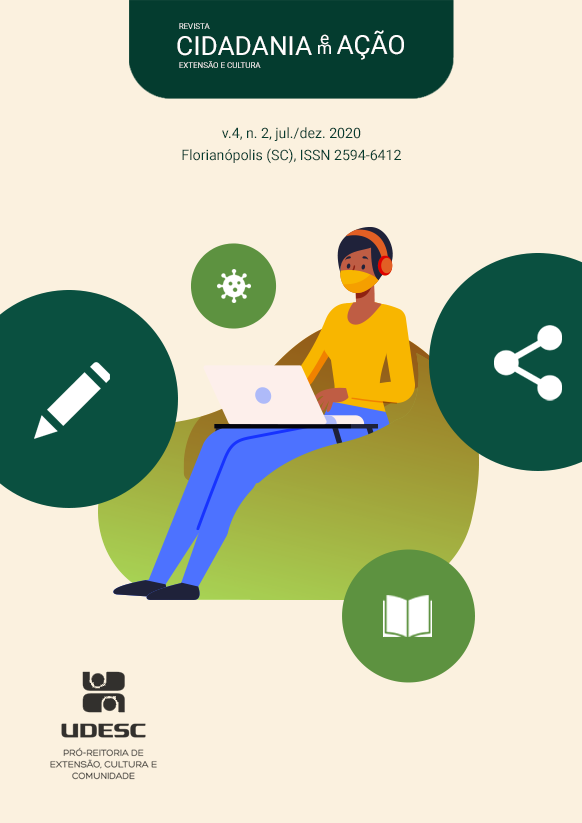DIGITAL LITERACY WITH LEGENDS FROM THE AMAZON AS AN INCENTIVE FOR READING AND WRITING OF STUDENTS RETAINED IN THE 3RD GRADE IN TWO PUBLIC SCHOOLS OF BELÉM-PA
DOI:
https://doi.org/10.5965/259464124256Keywords:
Literacy. Technologies. Digital literacy. Reading. Writing.Abstract
The use of technologies is a propitious way to insert and involve the student in digital reading and writing practices. Therefore, this report brings part of the actions of the extension project "Between legends and tales: the role of new technologies in the process of Literacy" with the objective of contributing to the process of digital literacy and reading-writing with Amazonian legends of 3rd grade students from public schools in Belém-PA. Two workshops are reported here, held in August and November 2018, with 3rd grade students from two public schools and under the leadership of graduates participating in the project. The first workshop had students from schools A and B, and the second, only students from school A. In workshop 1, students from the schools involved (A and B) participated in the telling of the legend of Curupira. In the sequence, they were guided to retell the legend in the form of comics, through the software "HagáQuê", producing the retextualization; this dynamic was repeated in workshop 2, in school A, with the legend of Boto. In the first workshop, a certain dexterity of the students was noticed regarding the use of the application, but with limitations in conventional writing, in the selection and combination of letters to type words and phrases, it isonly more evident in non-alphabetic students, although they all showed the interest in reading and writing or typing, attracted by the technological novelty. In the second workshop, held as a complement at school A, advances in digital handling and better writing performance were observed, compared to the moment of the workshop1, through the Hagáquê software. It was concluded that the use of digital technologies, as tools for literacy and literacy of students with difficulties in reading and writing, proved to be a timely strategy to face this challenging reality, as well as training the teacher who needs to know and know how to deal with these challenges, in favor of a digital literacy linked to the acquisition process of reading and writing in a social context. Keywords: Literacy. Technologies. Digital literacy. Reading. WritingDownloads
References
ALMEIDA, Maria Elisabeth Bianconcini de. ProInfo: Informática e Formação de Professores. Vol 1. Série de Estudos Educação a Distância. Brasília: Ministério da Educação. Seed, 2000.
BAKHTIN, M. Os gêneros do discurso. In: BAKHTIN, M. In: Estética da criação verbal. Trad. Paulo Bezerra.4 ed. São Paulo: Martins Fontes, 2006.
BIM, S. A. HagáQuê: editor de histórias em quadrinhos. 2001. Dissertação de mestrado. Universidade Estadual de Campinas, Capinas - SP, 2001.
CANCLINI, N. G. Culturas híbridas: Estratégias para entrar e sair da Modernidade.4 ed. São Paulo: Editora Universidade de São Paulo. 2003.
CANCLINI, N. G. Culturas híbridas: Estratégias para entrar e sair da Modernidade.4 ed. São Paulo: Editora Universidade de São Paulo. 2003.
FERREIRO, E.; TEBEROSKY, A. Psicogênese da língua escrita. Porto Alegre: Artes Médicas. 1985.
FREIRE, P. A importância do ato de ler: em três artigos que se completam. 23 ed. São Paulo: Autores Associados: Cortez, 1989.
GROSSI, E. P. Didática do nível alfabético (Didática da alfabetização, V. lll), Rio de Janeiro, Paz e Terra, 1990.
MARCUSCHI, L. A. Da fala para a escrita: atividades de retextualização. 10 ed. São Paulo: Cortez, 2010.
MORAES, R. de A. Informática na educação. Rio de Janeiro: DP&A. 2000.
NUNES, L. P; TRESCASTRO, L. B. Do filme à história em quadrinhos:
um trabalho de retextualização no 4º ano do ensino fundamental. Entrepalavras, Fortaleza, v. 6, n. 2, p. 353-369, jul./dez. 2016.
PAPERT, S. Logo: Computadores e Educação. São Paulo: Editora Brasiliense, 1985
POZO, J. I. Aprendizes e mestres: a nova cultura da aprendizagem. Porto Alegre: Artmed, 2002.
ROJO, R. Gêneros discursivos do círculo de Bakhtin e multiletramentos. In: ROJO, R. Escol@ Conectad@: os multiletramentos e as TICs. São Paulo: Parábola, 2013.
SOARES, M. Letramento: um tema em três gêneros. 3. ed. Belo Horizonte: Autêntica, 2009
SOARES, M. Novas práticas de leitura e escrita: letramento na cibercultura. Educação e Sociedade, Campinas, v. 23, n. 81, 2002. Disponível em:<http://www.cedes.unicamp.br> acesso: maio de 2018.
TFOUNI, L.V. Letramento e alfabetização. São Paulo: Cortez, 1995.
TRAVAGLIA, L. C. Gramática e interação: uma proposta para o ensino de gramática. 14. ed. São Paulo: Cortez, 2009.
VYGOTSKY, L. S. A formação social da mente: o desenvolvimento dos processos psicológicos superiores. 4 ed. São Paulo: Martins Fontes, 1991.
Downloads
Published
How to Cite
Issue
Section
Categories
License
Copyright (c) 2020 Citizenship in Action: Extension and Culture Magazine

This work is licensed under a Creative Commons Attribution 4.0 International License.












